Upon arrival in Luang Prabang you will be met by your guide for the transfer to your hotel. The remainder of your day is at leisure.
Luang Prabang, the ‘Jewel of Indochina’, is a UNESCO designated World Heritage Site and regularly voted as one of Asia's premier travel destinations. The ancient royal city is surrounded by mountains and is situated at a junction of the Mekong and Khan rivers.
In the centre of the city is Mount Phousi, rewarding climbers of its 328 steps with stunning views of the surrounding temples and hills. A city where time has seemingly stood still, Luang Prabang is also an outstanding example of the fusion of traditional Lao architecture with structures built by the Colonial authorities in more recent times. Its unique, remarkably well-preserved townscape illustrates a key stage in the blending of these two distinct cultural traditions.



An option for early-risers is to rise before dawn to witness tak bat, or the giving of alms, to the lines of orange-robed monks leaving their pagodas to receive offerings of food from the residents of Luang Prabang. It’s an iconic sight and for many one of the highlights of their stay in Luang Prabang, and can be arranged on any early morning during your stay. However, we are concerned that the volume of tourists all vying for space to witness, photograph and at times actually participate in this ceremony is detracting from what is a centuries old, important religious rite.
We appreciate that observing tak bat is high on the list of most visitors to Laos, and would suggest speaking with your guide about how best to enjoy this experience in a respectful and culturally sensitive manner, which can involve watching from a less congested spot.
Your city circuit begins after breakfast at the former Royal Palace, now the National Museum, which gives a good overview of the local history. The next section of the tour takes in some of the city’s temples, beginning with Wat Mai, a temple renowned for its golden bas-reliefs, before continuing on to Wat Xieng Thong, perhaps the most photographed temple in Luang Prabang, and the unique Wat Visoun, known as ‘The Water Melon Stupa’ due to its shape. Your last visit of the morning is the excellent Arts and Ethnology Centre which will give you further insight into the ethnic mix and culture of Laos.
In the afternoon visit the weaving and textile villages of Ban Xangkhong and Ban Xienglek before returning to town where you have three options to choose from. Either join the crowds by climbing up Mount Phousi, a sacred hill that offers spectacular sunset vista and a panoramic view over Luang Prabang and across the Mekong River. Alternatively if you'd prefer to avoid the steps, visit Wat Prabath Tai for a more accessible sunset experience. Your third option is to visit Wat Aham, where monks and novices come together in the colourful prayer hall for their daily rituals and chanting.



Your day is at leisure.



After breakfast drive out of Luang Prabang to the Living Lands Organic Farm, a community enterprise, where you will meet the local farming guide for an informative, but fun morning. Rice is an important part of life in Laos: it’s eaten at every meal and there are over 500 types of rice grown in the country.
During your time at the farm, you’ll learn about each step of the rice harvest and cultivation process, and try your hand at the traditional techniques (and basic tools) that have been used for centuries. The morning concludes with a rice tasting session, by which time you will have a much greater appreciation of the work and effort that goes into a simple bowl of rice!
Continue to Kuang Si Waterfalls, situated to the south-west of Luang Prabang, where you can enjoy a picnic lunch overlooking the falls. It’s possible to walk to the top and, if the weather is good, swim in the clear water at the foot of the falls. You can also visit the nearby Bear Rescue Centre that does a great job in protecting and rehabilitating the rare Asiatic Black Bear.
After time to relax, return to Luang Prabang where the remainder of your day is at leisure.



Morning departure by car for Phonsavan in the province of Xieng Khuang, famous for the ‘Plain of Jars’. It’s a long drive and the road follows a twisty mountain route, but you will pass through some stunning Lao mountain landscapes and the journey will be punctuated by stops en-route. During the morning, stops will be made at Ban Houi Hia, which offers great views of the surrounding mountains, and Ban Kiu Kharm Pom, a Khmu village where there will be time explore, before continuing on to Phou Khoun for lunch.
Having left Phou Khoun, the road climbs to 1500 metres above sea level, the highest altitude of the day, before you make a stop at Ban Sonboun, a Hmong village. The final stop of the day is a reminder that this region played a major part during the Vietnam War, as you visit a hidden Buddha Cave, that served as an army hospital during the war.
Arrive into Phonsavan be early evening and check in to your hotel. There are a few cafes and restaurants in town, catering for the intrepid travellers who make it here to explore the mysterious jars in the surrounding plains.



Your guide and driver are at your disposal throughout the day to explore Xieng Khuang Province.
First stop is the MAG (Mine Advisory Group) Centre in Phonsavan to learn about the valuable work undertaken to clear the region of the thousands of mines and UXO lying undetected. We have have supported MAG for a number of years and consider it to be amongst the most important NGO charitable organisations working out of Indochina today. Their vital work prevents literally thousands of unnecessary deaths every year.
Continue onto the newly opened Xieng Khouang Provincial Museum where exhibits include fields of archaeology covering different historical periods and the ethnic diversity of Laos. Short films focused on these subjects have been produced specifically for the benefit of visitors to the museum.
The remainder of the morning is dedicated to exploring the mysterious ‘Plain of Jars’, a newly designated UNESCO World Heritage Site. The impressive archaeological sites are covered with hundreds of mysterious jars, scattered across the surrounding plateau. The biggest jar measures over three meters in height and many are believed to be more than 2500 years old. There will be plenty of time to explore the three main sites and, due to its remoteness the crowds are likely to be a little thin on the ground!
Late afternoon you have the option of visiting the Lone Buffalo Foundation and Project. A community project based in Phonsavan, the foundation provides a unique environment in which students can study, develop and play sport. Have a chat, or play a language game while learning more about the Lone Buffalo Project. Afterwards, transfer to the Phou Xang viewpoint, to enjoy the panoramic sceneries and (hopefully) a beautiful sunset.

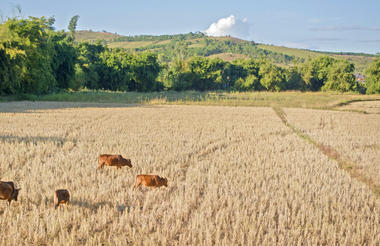
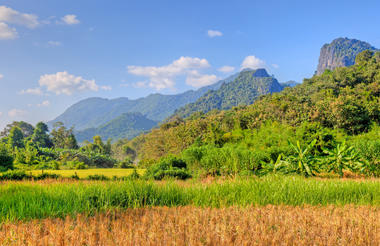
Today’s drive is long and in parts the roads are windy and slow. However the mountainous landscape is breathtaking and there are plenty of opportunities to break the journey at small villages and look-out points. You will also have the opportunity to stop at the village of Hintang where you will discover mysterious menhirs or standing stones. No one is quite sure who built them or why, one theory is that they mark burial sites.
Arriving in Sam Neua in the late afternoon, the remainder of your day is at leisure. Sam Neua is compact enough to wander around in an hour or so, and there are some interesting markets and restaurants to check out.



Begin the day with a short walk around Sam Neua town, making a visit to a weaving house showroom (the region is highly regarded for its weaving products, particularly the traditional Lao skirt or ‘Sin’). You can also walk along the river to visit the local wet market.
Transfer out of town in an easterly direction to Vieng Xai, famous for the caves that provided shelter for up to 23,000 Laotians during nine years of aerial bombardment during the ‘secret war’. The caves were also the Pathet Laos' HQ during this time. Some of the 480 caves have been made accessible to visitors to help bring much needed investment into one of the poorest regions in all South-East Asia.
An audio tour is provided and includes visits to the Kaysone Phomvihane (the leader of the Lao communist movement) Cave, and the Prince Soupanouvong (the ‘Red Prince’) Cave. You will also visit Artillery Cave with its commanding views across the surrounding countryside.
Having had plenty of time to explore the caves, transfer to your guesthouse in Vieng Xai, where the remainder of your day is at leisure.
There is a picturesque lake in the centre of the small town, and a pleasant lakeside restaurant at which to enjoy delicious North-East Laotian delicacies.



Morning transfer to the border point of Na Maew. Having crossed into Vietnam, you will be met by your new guide and continue by road to the spectacular Mai Chau Valley.
During your time in and around Mai Chau there will be plenty of opportunities to enjoy some light trekking or cycling, visit several minority tribe villages, explore caves, or simply relax in one of the most picturesque regions in Vietnam. The programme is very flexible and your guide will be happy to discuss alternative activities if required.
Upon arrival there will be time for lunch before exploring the countryside around Mai Chau on two wheels. Cycling is an excellent way to take in the rolling hills and traditional stilt-house villages dotted along the valley.
Having worked up an appetite, return to the comfort of your lodge where, in the evening, you will enjoy dinner and some traditional dances performed by the local Thái tribe people.



Today can be as active or as laid-back as you choose, with the option of staying close to the lodge and enjoying some short walks in the rice paddies or simply relaxing on the terrace appealing to many.
For those that wish to make a little more of their day, there are several Thái minority villages within an hours' drive of Mai Chau. This is a unique opportunity to learn about the culture, life style and daily activities of the ethnic people in the region, especially the White Thai and Muong tribes, whose lives have hardly changed for hundreds of years.
Take a walking tour to the scenic Buoc village, where you will encounter local farmers working on the terraced rice paddies and women preparing and cooking meals. Take time to speak with the locals and enjoy lunch in a local house, then continue your exploration of the scenic Van Mai valley, stopping for necessary photo opportunities (there are plenty!) Return to your lodge in time for dinner.



Morning departure for Ky Son, approximately 70kms to the west of Hanoi in the province of Xuan Son. The village, parts of which are over 200 years in age, is recognized as a National Cultural Historical Relic and your accommodation is in one of the detached, traditional style houses in the grounds of Nguyen family's own home. This is an ideal base to gain a hands-on insight into the rural way of life in this region without the sacrifice of comfort.
Throughout your stay at Ky Son, there will be plenty of opportunities to converse with the villagers who are always happy to stop and chat, giving you the chance to understand their culture and more traditional livelihoods. Enjoy a stroll around the pleasant village, soaking up the traditional North Vietnamese culture and lifestyle, before joining your host in preparing lunch.
In the afternoon, take your pick of several bike rides (ranging from 6 - 12 kms), setting out along local trails; stopping to enjoy the impressive panorama, pick herbs and vegetables, visit temples, chat with children and learn about the historical farming methods still deployed in this region. A visit to the village market is also recommended.
Return to the house in time for a relaxing traditional herbal bath and a home cooked meal.
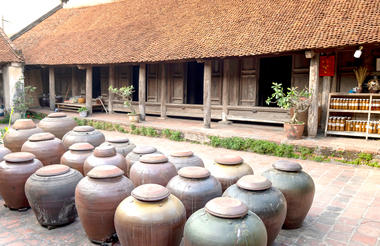
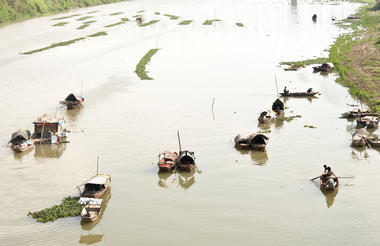
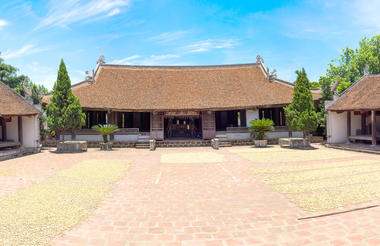
Enjoy a morning coffee before joining in with some traditional Yi Jin Jing exercises. Your hosts will also invite you to pray to Buddha and observe morning worship with the burning of false money and gold in respect for the family ancestors.
After breakfast enjoy a stroll or take a bike ride along the network of local paths, visiting the nearby villages of Cam Cao and Duong Lam, as well as the Mia Pagoda and Ngo Quyen tomb. Return to the house where there will be time to relax before lunch.
Transfer to Hanoi in the early afternoon, where the remainder of your day is at leisure.
Hanoi, Vietnam's capital, ranks amongst the world's most attractive and interesting cities. It was first the capital of Vietnam in A.D. 1010, and though the nation's capital moved to Hue under the Nguyen dynasty in 1802, the city continued to flourish after the French took control in 1888. In 1954, after the French departed, Hanoi was declared Vietnam's capital once again. The remnants of over 1,000 years of history are still visible here, with that of the past few hundred years wonderfully preserved.



Enjoy a full day tour of Hanoi; visiting some of the city’s classic sites alongside an introduction to Hanoi’s more contemporary side, interspersed with a handful of local experiences.
After breakfast, transfer the short distance to West Lake where bicycles will be waiting for a morning of cycling. Saddle up and set off around the lake. Also known as Tay Ho Lake, this large expanse of freshwater and its lakeside gardens attract locals looking for a quiet spot away from the busy streets of central Hanoi. Various historical places of interest are scattered around the perimeter including Vietnam’s oldest pagoda, Tran Quoc and Quan Thanh Temple, one of Vietnam’s four sacred temples. Stops will be made to visit one of the ancient pagodas that dot the route and enjoy a drink in one of the lakeside cafés, watching the world go by.
Mid-morning, transfer by car to the Temple of Literature, the site of Vietnam's first national university. Built in 1070, this complex of atmospheric halls, pavilions and courtyards is dedicated to Confucius and scholars. It's one of the few remaining examples of traditional Vietnamese architecture still standing in Hanoi: of special note are the 82 stone steles shaped like turtles which are elaborately carved with the names of candidates that sat the Royal examinations.
From here continue to Trang Tien Street near the Opera House for lunch. Popular with students and office workers, this narrow alley fills with street side stalls at lunchtime selling everything from pho and fried rice to sticky sweet treats. Pull up a plastic stool and tuck into lunch, Vietnamese-style.
After lunch, it’s time to explore Hanoi’s contemporary culture. Throughout the capital there are rumblings of creativity and entrepreneurial spirit, a step away from traditionalism and the rise of fresh and fashionable places. Manzi Art Café is one of Hanoi’s increasingly popular part café, part art gallery ventures. Set in a French Colonial villa in a relatively quiet Hanoi street, it’s the sort of place where you could easily while away a couple of hours drinking Vietnamese coffee and browsing the artwork. Sadly you won’t have so much time to spare, but there will certainly be time for coffee before walking to the Old Quarter. In contrast to your tranquil cycle ride around West Lake, a stroll through this historical area is an assault on the senses; its maze of narrow alleys are packed with scooters and street vendors, lined with restaurants, traditional workshops, souvenir shops and pagodas. The best way to absorb the atmosphere is with a local fresh beer at one of the bia hoi bars on Ta Hien Street.
Having enjoyed a beer and thoroughly explored Hanoi return to your hotel. Alternatively those wanting to spend more time in and around the Old Quarter may choose to take a taxi back to their hotel at a later stage.



Your day is at leisure until your transfer to Hanoi Airport for your onward flight.






